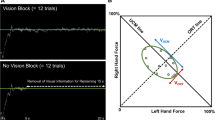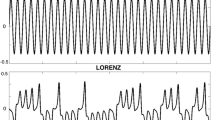Abstract
It is well established that older adults are more variable in their force output and that this age-related decrement is mediated by visuomotor processing. The purpose of this investigation was to examine whether the type of visual display impacts age-related differences in the control of force output. In order to address this question, young and old participants produced constant isometric force via index finger abduction to 3 force levels [5, 10, and 20% of their maximal voluntary contraction (MVC)]. Visual feedback was presented with either a compensatory or a pursuit display. A compensatory display provides visual feedback about force amplitude in relation to the criterion target whereas a pursuit display provides visual feedback about the force trajectory in relation to the criterion target and preview of the target path of the force trajectory. The magnitude of force variability was indexed with standard deviation and coefficient of variation. The structure of force output was indexed with spectral slope and approximate entropy. As expected, older adults were more variable and had more structured force output compared to younger adults. Moreover, this age-related difference in force control was paramount in pursuit displays. Overall, the findings suggest that age-related differences in force control are centrally mediated. It is proposed that older adults have deficits in visuomotor processing and this may be partly related to age-related decrements in the control of eye movements.



Similar content being viewed by others
References
Cerella J (1990) Aging and information processing rate. In: Birren J, Schaie KW (eds) Handbook of psychology and aging. Academic Press, New York, pp 201–221
Christou EA, Carlton LG (2001) Old adults exhibit greater motor output variability than young adults only during rapid discrete isometric contractions. J Gerontol 56:524–532
Craik KJW (1947) Theory of the human operator in control systems. Part 1. Br J Psychol 38:56–61
Deutsch KM, Newell KM (2001) Age differences in noise and variability of isometric force production. J Exp Child Psychol 80:392–408
Enoka RM, Christou EA, Hunter SK, Komatz KW, Semmler JG, Taylor AM, Tracy BL (2003) Mechanisms that contribute to differences in motor performance between young and old adults. J Electromyogr Kinesiol 13:1–12
Galganski ME, Fuglevand AJ, Enoka RM (1993) Reduced control of motor output in a human hand muscle of elderly subjects during submaximal contractions. J Neurophysiol 69:2108–2115
Goodwin AW, Fender DH (1973) Recognition of component differences in two-dimensional oculomotor tracking tasks. Vision Res 13:1905–1913
Heffernaan KS, Sosnoff JJ, Ofori E, Jae SY, Baynard T, Collier SR, Fernhall B (2009) Complexity of force output during static exercise in individuals with Down Syndrome. J Appl Physiol 106:1227–1233
Kao HS (1976) Effects of intermittency of feedback on a compensatory tracking task. Percept Mot Skills 43:1339–1345
Kornatz KW, Christou EA, Enoka RM (2005) Practice reduces motor unit discharge variability in a hand muscle and improves manual dexterity in old adults. J Appl Physiol 98:2072–2080
Lipsitz LA (1995) Age-related changes in the "complexity" of cardiovascular dynamics: a potential marker of vulnerability to disease. Chaos 5:102–109
Miall RC, Jackson JK (2006) Adaption to visual feedback delays in manual tracking: evidence against the Smith Predictor model of human visually guided action. Exp Brain Res 172:77–84
Miall RC, Weir DJ, Stein JF (1985) Visuomotor tracking with delayed visual feedback. Neuroscience 16:511–520
Morrow MJ, Sharpe JA (1992) Smooth pursuit initiation in young and elderly subjects. Vision Res 33:203–210
Moscher C, Baloh RW (1994) Age-related changes in visual tracking. J Gerontol 49:M235–M240
Pesce C, Guidetti L, Baldari C, Tessitore A, Capranica L (2005) Effects of aging on visual attentional focusing. Gerontology 4:266–276
Pincus SM (2001) Assessing serial irregularity and its implications for health. Ann NY Acad Sci 954:245–267
Prodoehl J, Vaillancourt DE (2009) Effects of visual gain on force control at the elbow and ankle. Exp Brain Res 200:67–79
Ranganathan R, Newell KM (2008) Online feedback and the regulation of degrees of freedom in motor control. Hum Mov Sci 27:577–589
Rottach KG, Zivotofsky AZ, Das VE, Averbuch-Heller L, Discenna AO, Poonyathalang A, Leigh RJ (1996) Comparison of horizontal, vertical, and diagonal smooth pursuit eye movements in normal human subjects. Vision Res 36:2189–2195
Slifkin AB, Newell KM (1999) Noise, information transmission, and force variability. J Exp Psychol Hum Percept Perform 25:837–851
Slifkin AB, Vaillancourt D, Newell KM (2000) Intermittency in the control of continuous force production. J Neurophysiol 82:1991–1998
Sosnoff JJ, Vaillancourt DE, Newell KM (2004) Aging and rhythmical force output: loss of adaptive control of multiple neural oscillators. J Neurophysiol 91:172–181
Sosnoff JJ, Newell KM (2005) Intermittent visual information and the multiple time scales of visual motor control of continuous isometric force production. Percept Psychophys 67:335–344
Sosnoff JJ, Newell KM (2006a) Information processing limitations with aging in the visual scaling of isometric force. Exp Brain Res 170:423–432
Sosnoff JJ, Newell KM (2006b) The generalization of perceptual-motor intra-individual variability in young and old adults. J Gerontol B Psychol Sci Soc Sci 61:304–310
Sosnoff JJ, Newell KM (2007) Are visual feedback delays responsible for aging-related increases in force variability? Exp Aging Res 33:399–415
Sosnoff JJ, Newell KM (2008) Age-related loss of adaptability to fast time scales in motor variability. J Gerontol B Psychol Sci Soc Sci 63:344–352
Taylor AM, Christou EA, Enoka RM (2003) Multiple features of motor-unit activity influence force fluctuations during isometric contractions. J Neurophysiol 90:1350–1361
Tracy BL, Dinenno DV, Jorgensen B (2007) Aging, visuomotor correction, and force fluctuations in large muscles. Med Sci Sports Exerc 39:469–479
Vaillancourt DE, Newell KM (2003) Aging and the time and frequency structure of force output variability. J Appl Physiol 94:903–912
Vaillancourt DE, Slifkin AB, Newell KM (2001) Intermittency in the visual control of force in Parkinson's disease. Exp Brain Res 138:118–127
Welsh SJ, Dinneno DV, Tracy BL (2007) Variability of quadriceps femoris motor neuron discharge and muscle force in human aging. Exp Brain Res 179:219–233
Wickens CD, Hollands JG (1999) Engineering psychology and human performance. In: Wickens CD, Hollands JG (eds), 3rd edn. Prentice Hall, Upper Saddle River
Wishart LR, Lee TD, Cunningham SJ, Murdoch JE (2002) Age-related differences and the role of augmented visual feedback in learning a bimanual coordination pattern. Acta Psychol 110:247–263
Author information
Authors and Affiliations
Corresponding author
Rights and permissions
About this article
Cite this article
Ofori, E., Samson, J.M. & Sosnoff, J.J. Age-related differences in force variability and visual display. Exp Brain Res 203, 299–306 (2010). https://doi.org/10.1007/s00221-010-2229-z
Received:
Accepted:
Published:
Issue Date:
DOI: https://doi.org/10.1007/s00221-010-2229-z




